Quiz Answer Key and Fun Facts
1. In what part of the world will you find the country of Bosnia and Herzegovina?
2. The national flag of Bosnia and Herzegovina was adopted in 1998. Which of these is a reason for the choice of an isosceles triangle as a main feature of the flag?
3. This is an image from the medieval artefact known as Hval's codex. In what alphabet was the majority of this illuminated manuscript written?
4. The region that is now Bosnia and Herzegovina was known as the Eyalet of Bosnia when it was part of which empire?
5. The assassination of the Austro-Hungarian Archduke Franz Ferdinand in 1914 was one of the final triggers to World War I. In what city, now the capital of Bosnia and Herzegovina, did this occur?
6. Ivo Andric was described as Yugoslav when he received what award in 1961?
7. What kind of dance is the kolo, a popular folk dance in Bosnia and Herzegovina?
8. This image shows the stecci (medieval tombstones) you can see at the UNESCO heritage site of Radimlja.
9. Why did the village of Medjugorje become a centre of world attention in 1981?
10. For what purpose was the Avaz Twist Tower constructed in Sarajevo?
Source: Author
looney_tunes
This quiz was reviewed by FunTrivia editor
agony before going online.
Any errors found in FunTrivia content are routinely corrected through our feedback system.

